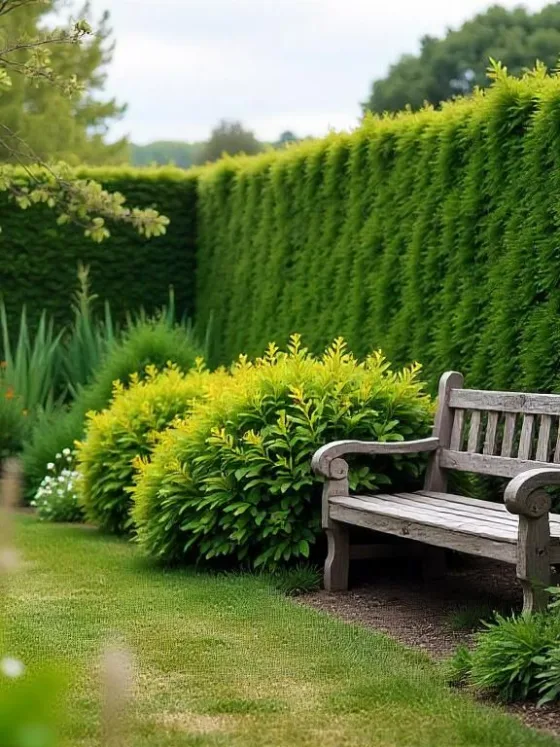Table of Contents Show
Introduction
Imagine stepping into your backyard and feeling like you’re in the Mediterranean. It’s not just a dream—it can become a reality. Mediterranean makeovers for outdoor spaces are all about capturing the essence of this region’s idyllic lifestyle: lazy afternoons basking in the sun, vibrant landscapes that burst with color, and a sense of tranquility that can turn any garden into a relaxing oasis.
In this guide, we’ll explore the world of trendy outdoor living and discover how to design gardens that go beyond looks. We’ll learn how to transform any ordinary outdoor area into a Mediterranean paradise, combining beauty with practicality.
Whether you have a small balcony or a large yard, the Mediterranean style has its charm. It’s more than just adding plants; it’s about creating an immersive experience that transports you to sunny beaches every time you step outside.
To add to the allure of your outdoor space, consider incorporating houseplants in winter as well. Discover the benefits of having houseplants in winter and learn how to keep your indoor garden alive and thriving even during the colder months. This will not only improve air quality but also boost mood and productivity while enhancing your home decor with vibrant greenery.
Ready to get started? Let’s begin this journey together and turn your outdoor space into a peaceful getaway, one step at a time. And if you’re expecting or planning for a little one, we even have some ideas and suggestions for decorating a frog-themed nursery that might interest you!
1. Garden Design Inspiration with a Mediterranean Touch
Whether you’re an aspiring garden designer or simply want to revamp your outdoor space, infusing it with a Mediterranean flair can transform it into a serene and inviting area. This section delves into the process of transforming a dull courtyard into a vibrant oasis, discusses the benefits of porcelain paving, and terracotta pots, and explores how raised beds and pergolas contribute to the overall aesthetic.
Case Study: Transforming a Dull Courtyard into a Mediterranean Paradise
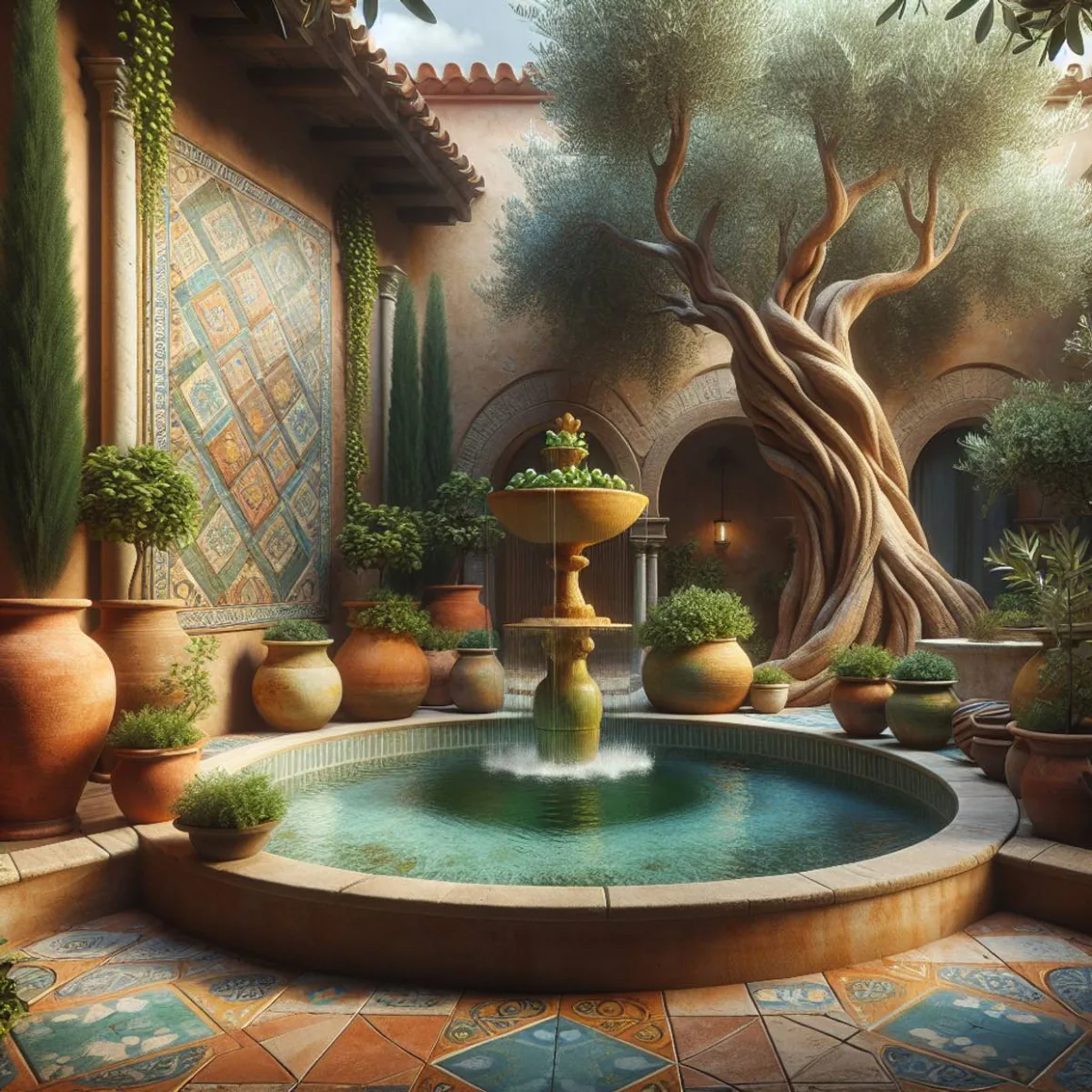
The once-plain courtyard was turned into an outdoor haven reminiscent of the scenic landscapes found along the Mediterranean coast. The transformation was captured in before-and-after photos that showcased the dramatic changes brought about by strategic design elements.
The Power of Porcelain Paving
The first move in this transformation was to replace the old concrete slabs with porcelain paving. Not only did it add visual appeal, but porcelain paving also proved to be functional – its durability withstands harsh weather conditions and requires minimal maintenance. Its non-slip surface also makes it safe to walk on even when wet, an essential feature for any outdoor space.
“Porcelain paving added elegance and practicality to my courtyard. It instantly elevated the look while being easy to clean and maintain.” – Homeowner
Terracotta Pots: Versatile and Charming
Another transformative element introduced was terracotta pots. Arranged in clusters or used as standalone features, these pots added depth to the landscape while providing room for plantings. When choosing terracotta pots, consider varying their sizes for visual interest. Large pots can host small trees or shrubs, while smaller ones are perfect for vibrant flowers or trailing plants.
“I love how terracotta pots bring an earthy warmth to my garden. They’re like pieces of art that also hold my favorite plants.” – Homeowner
For those keen on designing their landscape, this case study serves up some inspiration on creating an outdoor space that not only resonates with the Mediterranean vibe but also meets the homeowner’s functional needs.
The Role of Raised Beds and Pergolas in Mediterranean Garden Design
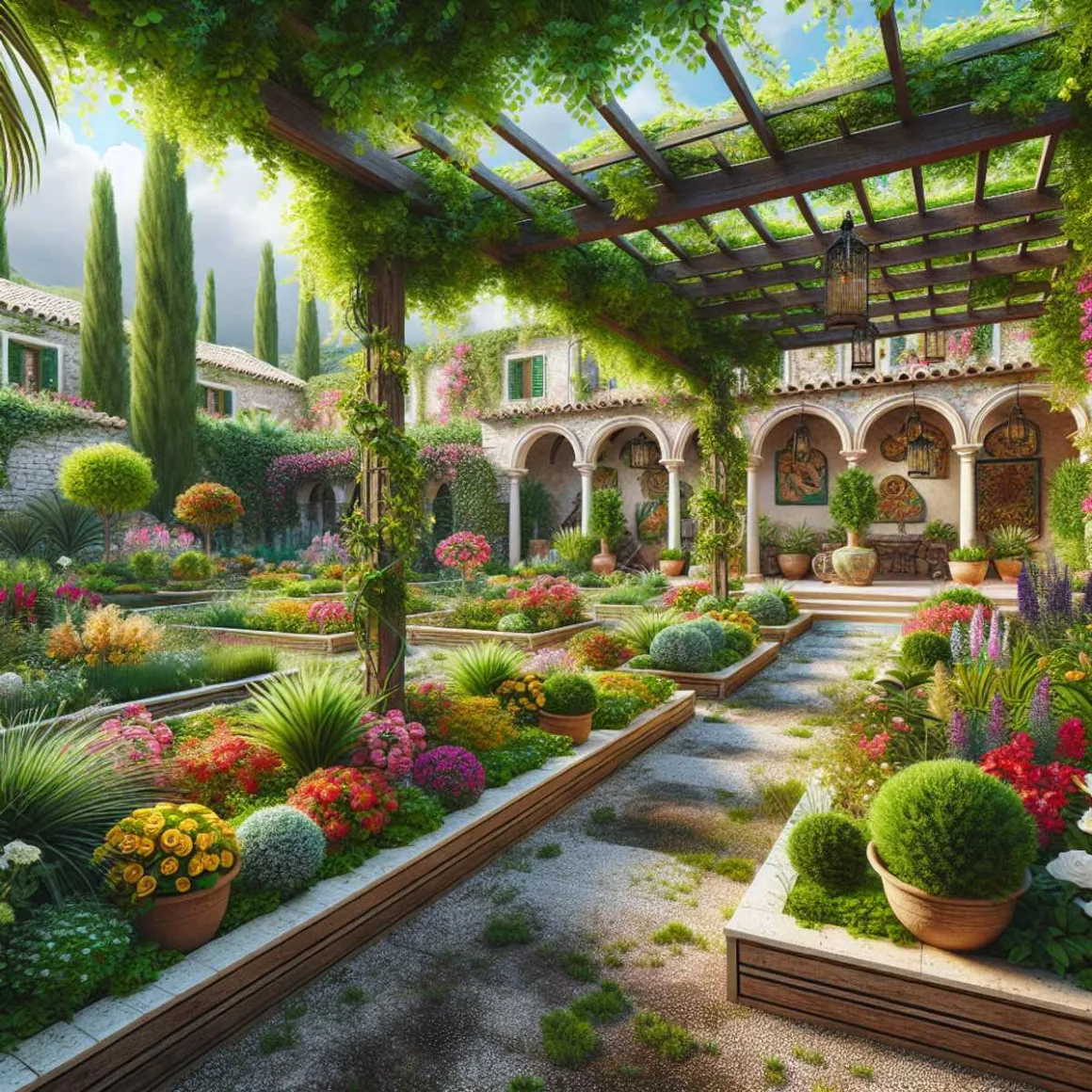
Raised beds add depth and versatility to gardens, ideal for growing a range of plants that contribute to a Mediterranean vibe. These beds also enhance soil drainage, perfect for Mediterranean plants requiring well-drained conditions.
In a Mediterranean courtyard garden, specific plants like olive trees, lavender, and rosemary were chosen for their adaptability to the Mediterranean climate and aesthetic appeal.
A pergola was essential in this transformation. It served as a shaded spot for outdoor relaxation or dining, with its design aligning with the overall style. A wooden pergola adorned with climbing vines provided shade and a romantic touch reminiscent of Italian vineyards.
The use of raised beds and pergolas can transform an outdoor space into one that embodies the Mediterranean charm. By choosing appropriate plants, incorporating raised beds for functionality and depth, and adding a pergola for shade and ambiance, you can create a haven reflecting the region’s aesthetics while providing relaxation and enjoyment. No matter the size of your garden, careful design choices can bring the warmth and beauty of the Mediterranean to your doorstep.
Raised beds are quintessential features in a Mediterranean courtyard garden. These elevated plots prevent soil compaction, improve drainage, and serve as focal points displaying vibrant hues and varied textures of Mediterranean flora. When planning your raised beds, consider these essentials:
1. Plant Selection for a Mediterranean Garden
Creating an authentic Mediterranean garden begins with the right plant selection. The plants chosen should be able to flourish under the warm sun, mirroring the natural landscapes found along the Mediterranean coast.
The following are some excellent choices for your garden:
- Lavender: Known for its intoxicating scent and beautiful purple flowers, lavender is a true staple of the Mediterranean landscape. This plant is highly drought-tolerant, making it an ideal choice for areas with hot, dry summers.
- Sage: Another drought-tolerant species, sage brings a touch of silvery green to your garden. It’s also known for its aromatic leaves, which are often used in cooking.
- Thyme: Thyme is a versatile plant that thrives in full sun and well-drained soil. It offers tiny but fragrant flowers and comes in several varieties to add interest to your garden design.
These plants not only capture the essence of the Mediterranean region but are also sustainable choices due to their minimal water requirements. By opting for these species, you’ll create an authentic and eco-friendly garden space that’s both visually appealing and easy to maintain.
Note: While these plants are typically resilient, it’s crucial to ensure they’re planted in well-draining soil to prevent waterlogging during wetter periods.
2. Design & Structure
Choose natural stone or durable materials like brick to construct the walls of your raised beds. This choice reinforces the Mediterranean aesthetic and ensures longevity.
Although raised bed planting might seem like a task you can tackle on your own, enlisting a professional garden designer can provide an extra layer of expertise to truly capture the essence of a Mediterranean courtyard garden transformation.
Pergolas, used in tandem with raised beds, is an architectural gift that blends beauty and function seamlessly. They provide much-needed shade without compromising on style.
3. Choosing the Right Pergola Materials
When planning your Mediterranean courtyard garden, the choice of pergola materials is an important consideration. The materials you choose can significantly influence the overall aesthetic and functionality of your pergola, and by extension, your garden.
Traditional Pergola Materials
Traditionally, pergolas are constructed from wood or wrought iron. These materials are popular for their natural appeal and classical elegance respectively.
- Wood: Often used in traditional garden designs, wood is loved for its organic look and feel. It easily blends with the surrounding nature and can be stained or painted to match any design scheme. However, it requires regular maintenance to prevent rotting and termite infestation.
- Wrought Iron: Wrought iron lends a timeless elegance to your pergola design. It’s highly durable and sturdy, able to withstand harsh weather conditions. However, it may require periodic painting to prevent rusting.
Modern Pergola Materials
In recent years, more homeowners have explored modern alternatives that offer the beauty of traditional materials with less upkeep. A popular choice is aluminum.
- Aluminum: Lightweight yet strong, aluminum offers a contemporary look for your pergola. It can be powder-coated to mimic the textures of wood or wrought iron, making it versatile in design options. One of its key advantages is its ease of maintenance – it resists rusting and rotting, making it a durable choice for long-term use.
Remember, the right material for your pergola depends largely on your personal preference, budget considerations, and maintenance capacity. Consider these factors carefully before deciding to ensure that your Mediterranean courtyard garden truly reflects your vision.
4. Design Variations
Whether you prefer a minimalist structure draped with climbing vines or a grand pergola with intricate patterns casting playful shadows, there’s a design out there to suit your vision.
Pairing porcelain paving with these elements elevates the entire outdoor space design. Porcelain paving is beneficial for its non-slip properties and resistance to weather extremes—essential qualities for any Mediterranean courtyard garden.
Terracotta pots placed around or arranged at different heights within raised beds add warmth and charm. Picture them brimming with aromatic herbs or spilling over with cascading blooms; they’re as practical as they are picturesque.
For those eager to roll up their sleeves, designing and maintaining raised beds can be a rewarding DIY project. Tips for success include:
- Ensuring adequate sunlight exposure
- Incorporating proper irrigation systems
- Selecting complementary plants for year-round interest
However, if budget allows, hiring a professional garden designer can ensure that every detail contributes towards achieving an idyllic outdoor retreat.
Whether you’re building from scratch or infusing Mediterranean charm into an existing space, remember that each element – from raised beds to pergolas – plays its part in crafting that desired sun-drenched coastal ambiance right in your backyard.
If you’re looking to refresh your space without breaking the bank, consider these affordable home upgrades that can give your home a luxurious look without costing a fortune. These tips can easily be applied to your garden design as well.
Additionally, if you want to tackle tough cleaning tasks in your garden, such as removing stubborn dirt from your raised beds or pergolas, you might find this guide on how to transform your hose into a pressure washer helpful. With just a few inexpensive attachments, you can achieve amazing results using this DIY method, saving money on expensive pressure washers.”
Embracing the Trend of Outdoor Living with Mediterranean Flair
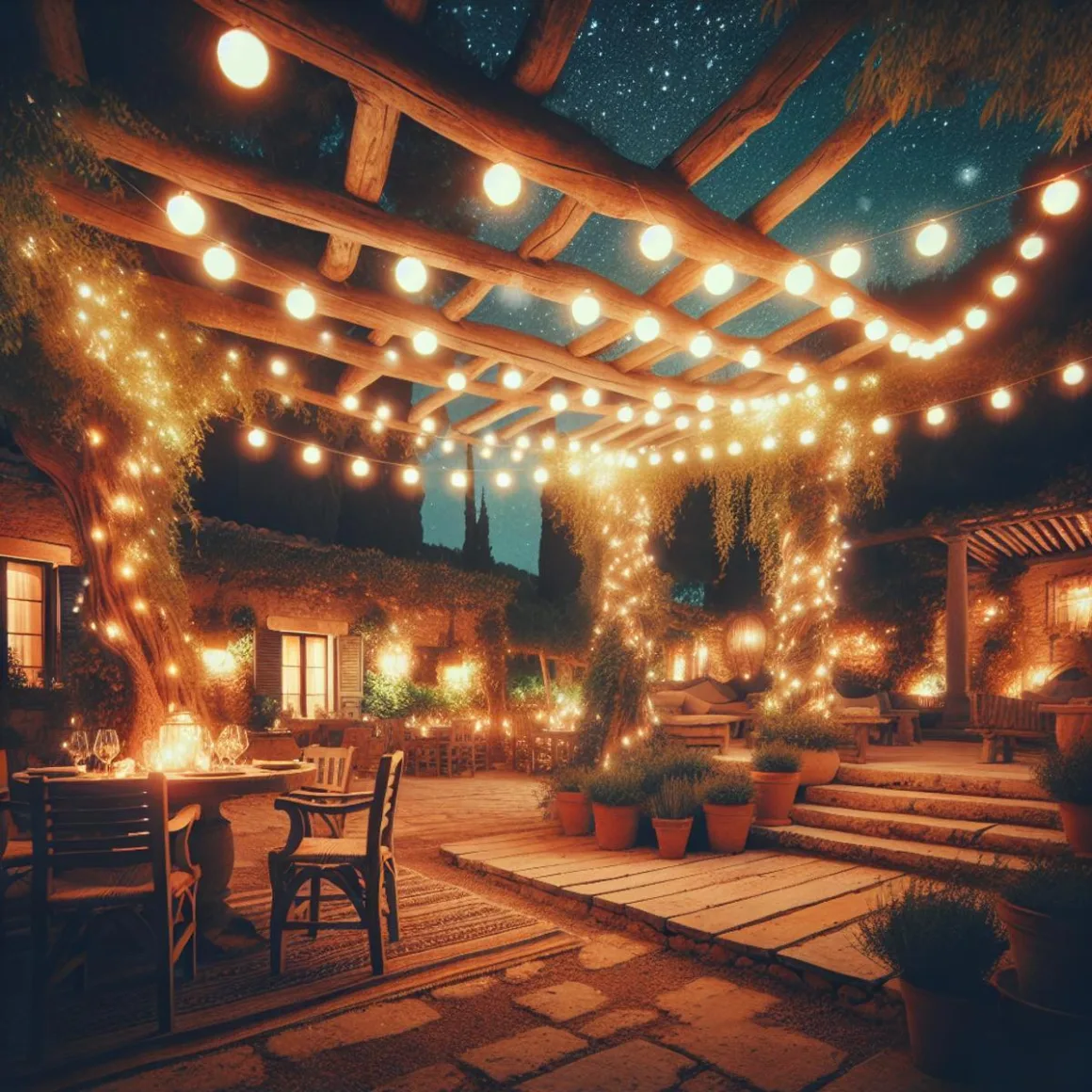
Captivating Nightscape: Using Festoon Lights to Illuminate Your Outdoor Haven
The charm of a Mediterranean evening is incomplete without the ambient glow of festoon lights. These string lights have become synonymous with the warm and inviting outdoor spaces that grace homes from the rolling hills of Tuscany to the coastal retreats of the Costa del Sol. Picture this: strands of lights crisscrossing above, casting a soft luminescence that beckons for leisurely dinners al fresco or relaxed conversations under the stars.
To integrate this magical element into your space:
- Select festoon lights that complement the scale of your outdoor area. Larger bulbs can create a bold statement, while smaller ones might offer a more understated elegance.
- Consider LED options for energy efficiency and longer-lasting bulbs that ensure countless nights of uninterrupted ambience.
- Strategically place hooks or poles around your garden or patio to support the weight of the lights and allow for a taut, neat display.
- Vary light heights to add dimension and interest—some close enough to provide intimate lighting over seating areas, others draped higher to illuminate walkways.
Outdoor Furniture Options: Creating a Relaxing Mediterranean Vibe
When it comes to selecting furniture for your outdoor space, it’s essential to choose pieces that not only look good but also make you feel comfortable and at ease. Here are some tips for finding the perfect outdoor furniture with a touch of Mediterranean flair:
- Choose natural materials such as wrought iron for its durability and timeless appeal, or go for teak and rattan for their ability to blend seamlessly into natural surroundings.
- Cushioned seating in neutral tones, accented with vibrant throw pillows in blues, greens, or terracotta, can echo the colors of the sea, sky, and earth found in Mediterranean landscapes.
- Consider multi-purpose furniture—like ottomans that double as extra seating or storage—to maximize space without sacrificing style.
For more inspiration on creating versatile outdoor living areas, explore Creative Solutions for Multipurpose Yards, which offer a delicate balance between kid-friendly spaces and grownup retreats.
DIY Outdoor Transformations: Simple Ideas with Big Impact
For those who enjoy getting their hands dirty and adding a personal touch to their outdoor spaces, here are some easy DIY projects that can elevate your Mediterranean-inspired haven:
- Paint existing furniture with weather-resistant paint to freshen up its look while protecting it from the elements.
- Create an outdoor rug using stencils and paint on a concrete patio floor to add color and define different zones within your space.
- Install a simple curtain system around your pergola for added privacy and protection from the sun or wind.
Spanish and Italian Influences: Adding Character to Your Outdoor Oasis
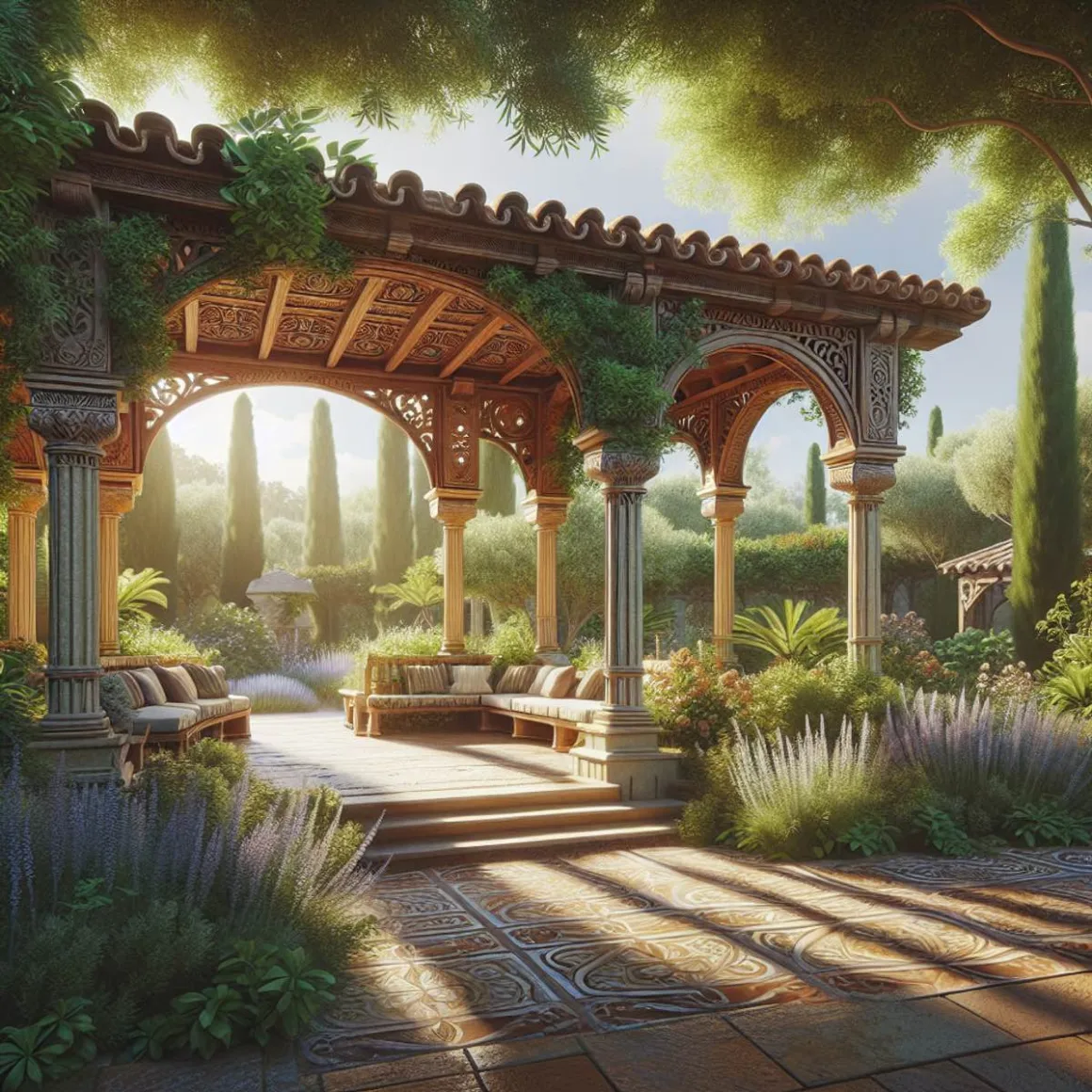
To fully embrace the spirit of Mediterranean living in your outdoor space, it’s crucial to incorporate elements that reflect the rich culture and aesthetics of Spanish and Italian design.
Infuse Spanish and Italian Influences
Consider integrating unique elements such as:
- Mosaic Tile Tabletops: These can bring a touch of color and artistic flair to your decor. The intricate designs on these tiles can also serve as an eye-catching centerpiece for your outdoor dining area.
- Decorative Wrought Iron Pieces: Whether used for furniture, gates, or ornamental accents, wrought iron is a staple in Mediterranean design. Its durability makes it perfect for outdoor use, while its intricate patterns add an old-world charm.
- Outdoor Pizza Oven: Not only does this provide a fun and interactive cooking experience, but it also serves as an attractive feature that embodies the heart of Italian family gatherings.
These touches serve not just as functional additions to your space, but also as conversation starters that capture the essence of Mediterranean hospitality.
“The key to Mediterranean design is creating a balance between functionality and aesthetics.”
Inspired Outdoor Dining Setups
When it comes to designing your outdoor kitchen or dining area, there are countless trends you could draw inspiration from [link here]. Options range from open-air kitchens for exhaustive cooking exercises to outdoor bars for relaxed entertaining.
Incorporate vibrant colors through tiles, natural stone textures for authenticity, and lush greenery for a touch of nature. This combination will effortlessly create a warm and inviting atmosphere synonymous with Mediterranean outdoor spaces.
Creating an Authentic Mediterranean Oasis
Above all else, remember that the secret to creating a truly authentic Mediterranean-inspired oasis lies in striking the right balance between practicality and visual appeal. Envision yourself lounging on a hand-painted ceramic bench, immersed in a good book or sipping on a glass of fine wine under the shade of a grapevine-covered pergola. These timeless design elements not only enhance the functionality of your space but also transport you to the sun-kissed shores of the Mediterranean.
Creating Intimate Gatherings: Designing Cozy Outdoor Living Spaces
One of the defining features of Mediterranean outdoor areas is how they perfectly combine beauty and practicality. This balance is especially evident in the choice of outdoor furniture that can turn gardens into perfect spots for small gatherings.
Outdoor Furniture: A Blend of Comfort and Style
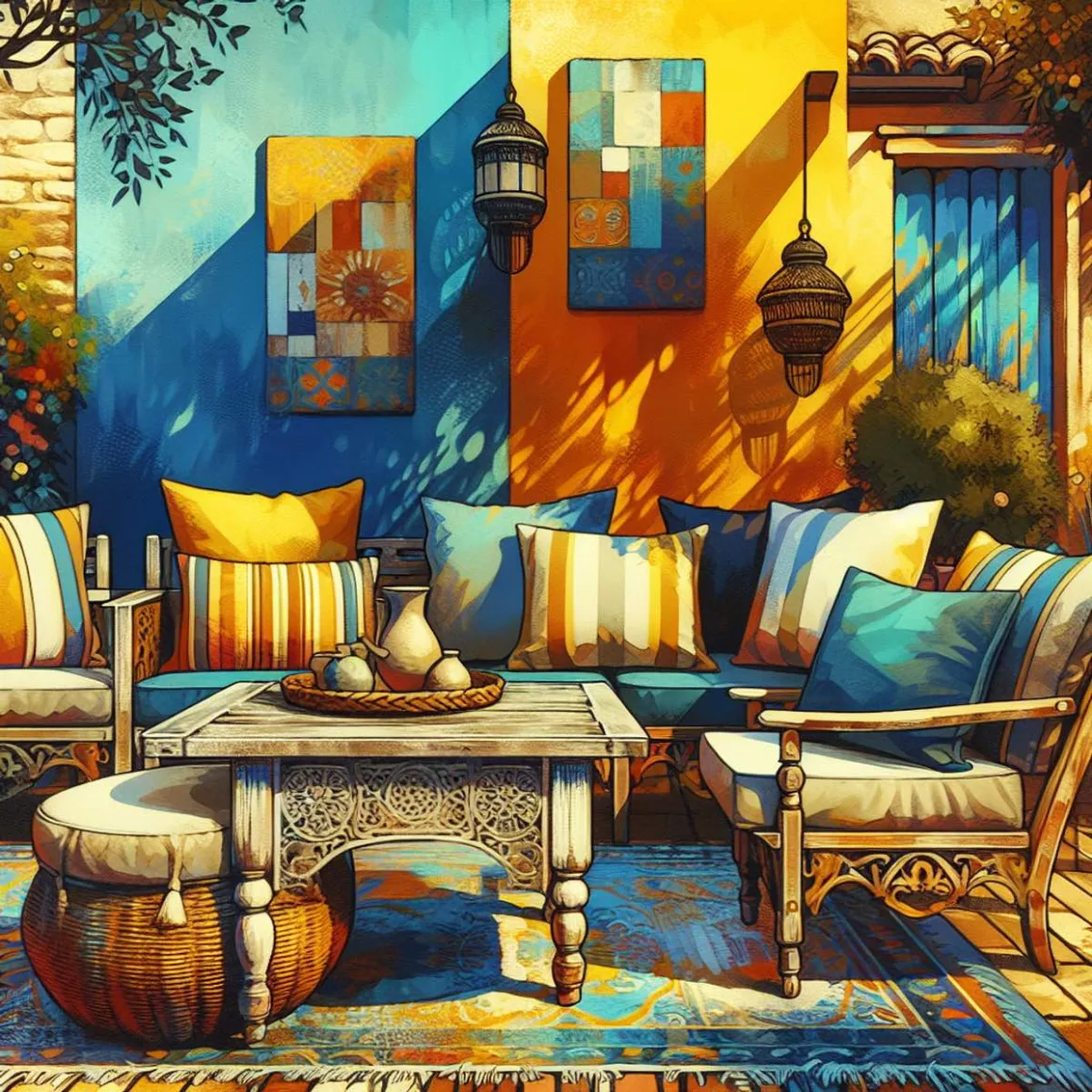
When picking out furniture for your Mediterranean-inspired outdoor area, it’s important to think about both comfort and style. Here are some tips:
- For lounging areas, opt for furniture with soft cushions covered in vibrant, weather-resistant fabrics that mirror the colors found in Mediterranean landscapes – like deep blues, bright yellows, and warm oranges.
- When it comes to dining areas, a long wooden table paired with simple chairs or benches can recreate the relaxed elegance seen in many Italian and Spanish courtyards.
- Don’t worry if you have limited space! Even a small bistro table with a couple of chairs can be a charming addition, perfect for enjoying a cup of coffee in the morning or a glass of wine in the evening.
Incorporating Indoor Elements
A key feature of Mediterranean-style homes is how they seamlessly connect indoor and outdoor spaces. You can achieve this same effect by bringing indoor elements outside:
- Colorful Tiles: Use them to add visual interest to walls, tabletops, or even as part of your flooring. Look for patterns with intricate designs or bold colors.
- Wrought Iron Accents: These can bring a touch of rustic charm to your outdoor area. Consider adding wrought iron railings to balconies or terraces, using decorative screens for privacy, or installing unique light fixtures.
DIY Transformations
Feeling crafty? Here are some simple do-it-yourself projects that can add a personal touch to your Mediterranean outdoor space:
- Painting Furniture: Give old pieces a new lease on life by giving them a fresh coat of paint in a color inspired by the Mediterranean.
- Creating a Mosaic Tabletop: Use colorful tiles to create a one-of-a-kind tabletop that becomes a conversation starter.
- Building a Pergola: Add shade and structure with a do-it-yourself pergola. You can further enhance it by letting climbing plants or sheer curtains hang from it.
Festoon Lights Installation
To create a truly enchanting atmosphere in your Mediterranean outdoor space, consider installing festoon lights. Here’s a simple guide to help you:
- Decide where you want to hang the lights – it could be between trees, from your house to a post, or under a pergola.
- Measure the length of the area where you want the lights to be.
- Purchase festoon lights that are long enough for your desired setup. If you’re unsure, it’s better to go for longer ones as you can always let them hang loosely for a softer look.
- Install sturdy hooks or eyes at each end of the light path and at regular intervals along it.
- Carefully string the lights, making sure they are securely attached to each hook or eye.
The result? A stunning nighttime scene that encourages relaxation and intimate gatherings beneath the twinkling stars.
As you can see, designing cozy outdoor living spaces with a Mediterranean touch involves careful furniture selection, clever incorporation of indoor elements, and even some fun do-it-yourself projects. With these ideas in mind, you’re well on your way to creating an inviting space that perfectly combines comfort and style.
3. Creating a Tranquil Atmosphere with Mediterranean Plants and Water Features
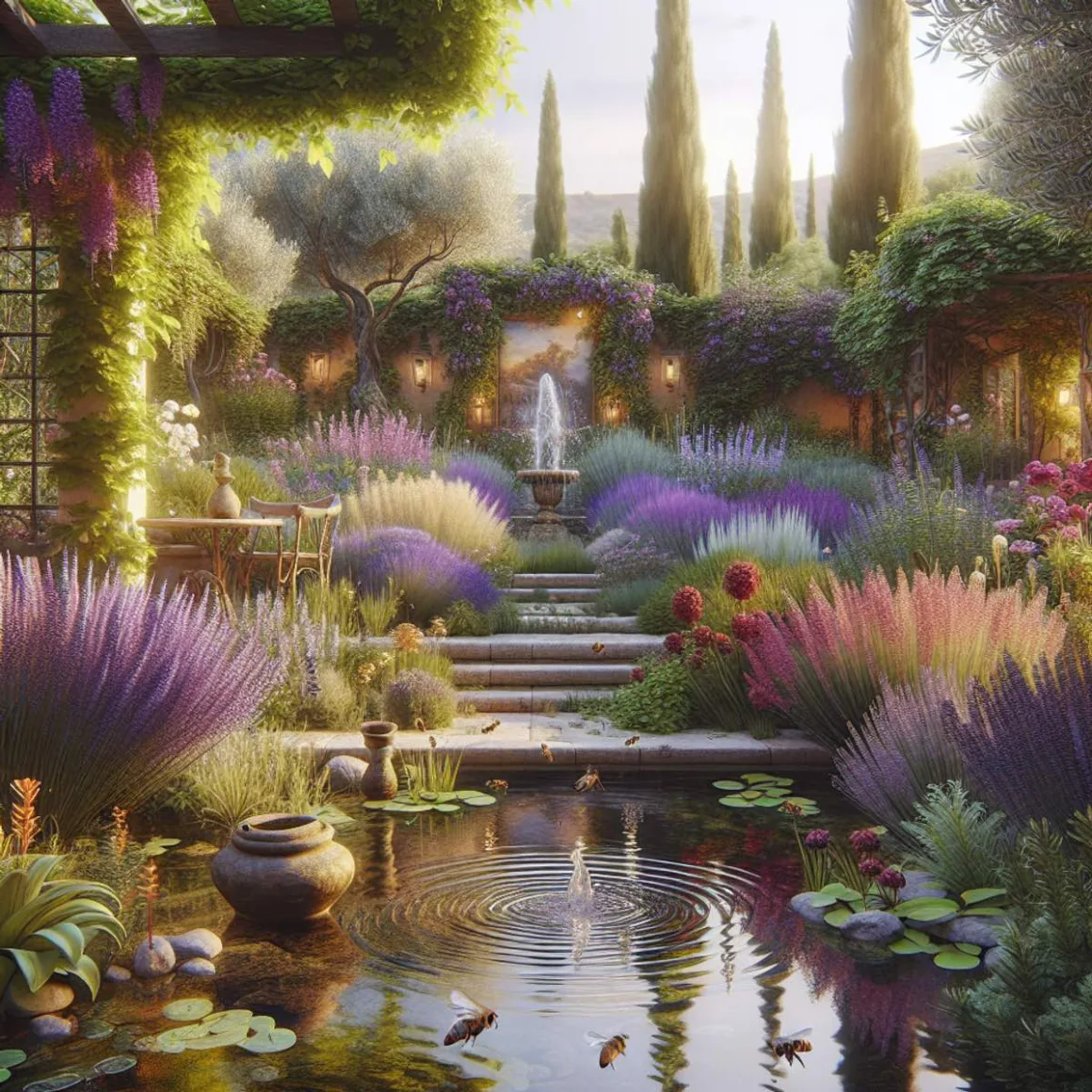
Imagine walking through a peaceful Mediterranean garden, with the scent of lavender, rosemary, and olive filling the air. Picture yourself surrounded by plants that can thrive in dry conditions, which are essential for a Mediterranean-style landscape.
The Importance of Plants That Can Withstand Drought
In Mediterranean climates, summers are often long and dry. This makes it crucial to choose plants that can survive with minimal water. Not only will these drought-tolerant plants stay healthy in such conditions, but they will also enhance the overall Mediterranean look and feel of your garden.
Here are some examples of drought-tolerant plants commonly found in Mediterranean gardens:
- Olive Trees: Known for their silvery-green leaves and twisted trunks, olive trees are a timeless option for Mediterranean landscapes. They are extremely resilient and only need watering occasionally once they have established themselves.
- Lavender: Besides its pleasant fragrance, lavender is also admired for its ability to thrive in arid environments. This plant adds both texture and color to your garden with its vibrant purple flowers.
- Rosemary: A sturdy perennial herb, rosemary flourishes when exposed to plenty of sunlight and planted in well-draining soil. Its needle-like leaves bring visual interest to your outdoor space while also offering culinary benefits.
- Sage: Available in various shades ranging from green to purple, sage is another type of plant that can withstand dry spells and thrives in sunny climates. It not only adds beauty to your garden but also attracts important pollinators like bees and butterflies.
Remember to use water-efficient gardening techniques to conserve water when caring for these plants.
Incorporating Calming Water Features
Water features play a crucial role in creating a sense of tranquility in a Mediterranean garden. They can be elaborate structures like large fountains or simple additions such as birdbaths – each one serving as a focal point that draws attention and fills the space with the soothing sounds of water.
Here are some popular types of water features for Mediterranean gardens:
- Fountains: A well-designed fountain can easily become the centerpiece of your outdoor area, providing a relaxing backdrop with its gentle flow of water. Look for styles that match your Mediterranean theme, such as ones made from stone or terracotta with intricate details.
- Tiled Pools: Tiled pools are another common sight in Mediterranean gardens. The use of turquoise and azure tiles resembling the colors of the Mediterranean Sea not only creates a stunning visual effect but also offers a refreshing spot to cool off during hot summer days.
- Birdbaths: If you prefer something simpler, adding a birdbath is an excellent choice. Not only does it serve as a water feature, but it also attracts birds, bringing an element of wildlife into your garden.
Keep in mind that proper upkeep is necessary for water features to remain clean and functional. Regularly check and clean them to prevent the growth of algae and ensure that the water stays clear.
By incorporating plants that can thrive in dry conditions and integrating calming water features, like canvas prints, you’ll be well on your way to creating an authentic Mediterranean atmosphere in your outdoor space.
4. Extending Your Outdoor Season: Fire Pits and Cozy Accessories for Cool Evenings
The Mediterranean lifestyle embraces the outdoors year-round, not only during warm summer months. And with a few smart additions, you too can extend your outdoor season into chillier evenings.
Fire Pit Design and Placement
Adding a fire pit to your outdoor space is an ideal way to create a cozy atmosphere during cool nights. The warmth of the fire allows you to enjoy the outdoor living area even when temperatures drop. However, the design and placement of the fire pit are crucial elements that should be considered carefully.
Choosing the Right Design
When selecting a fire pit design, consider one that complements your Mediterranean theme. Opt for materials like wrought iron or rustic stone that blend well with this style’s earthy palette and natural textures. A circular or square shape is typically more fitting for this design aesthetic.
Finding the Perfect Spot
The placement of your fire pit should provide a focal point within your outdoor space without disrupting the flow of movement or posing safety risks. Ideally, it should be situated at a central location that is comfortably accessible from various seating areas. Remember, safety comes first! Ensure the fire pit is located away from any flammable structures or plants.
Outdoor Textiles: Plush Cushions and Warm Blankets
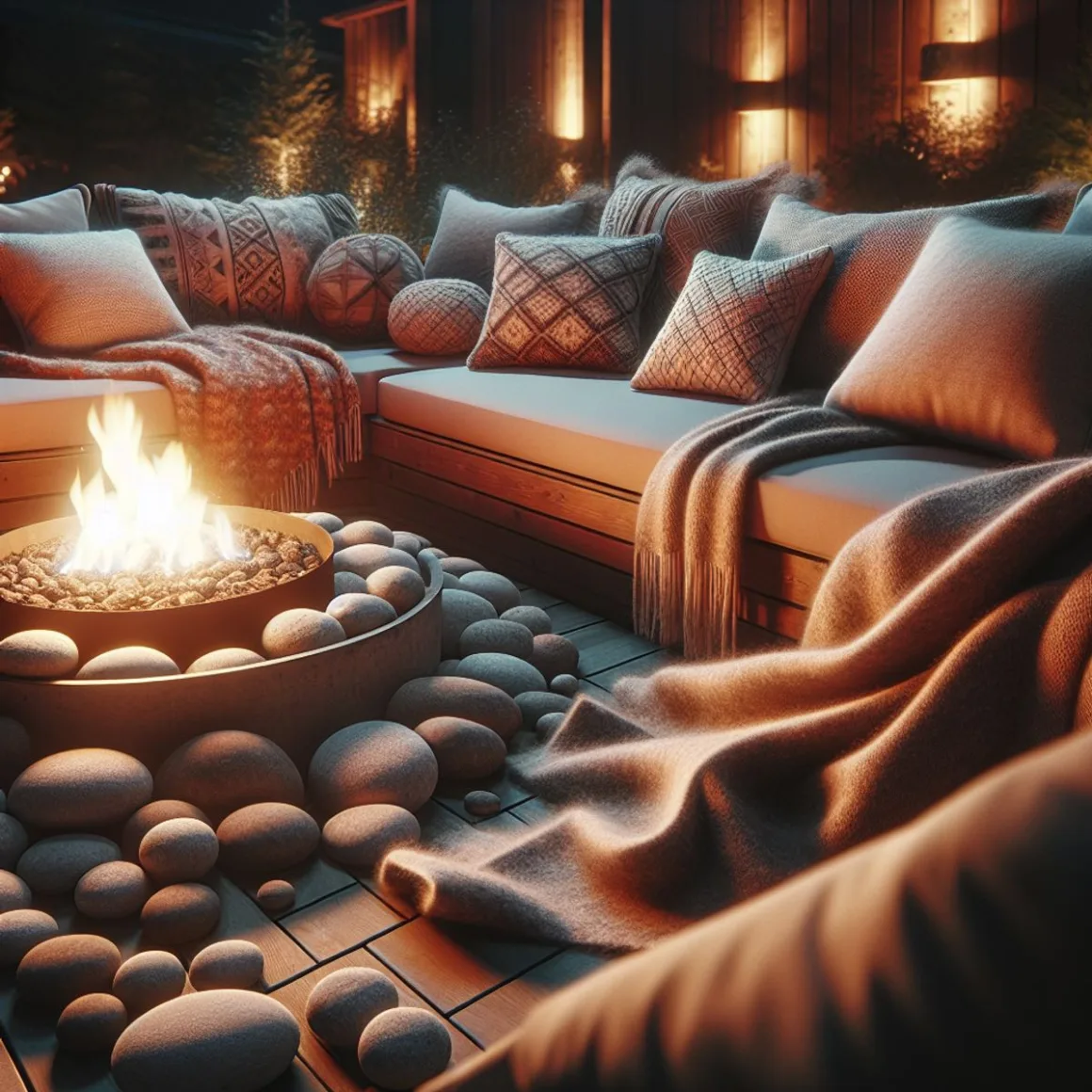
Beyond just the fire pit, cozy accessories also play an integral role in making your outdoor space inviting during cooler evenings. Think plush cushions and warm blankets — these not only add comfort but also contribute to the overall aesthetic of your Mediterranean-inspired design.
Choosing Cushions Wisely
For cushions, opt for fabrics that are durable and weather-resistant, yet comfortable and stylish. Consider patterns that reflect Mediterranean culture, such as intricate tile motifs or botanical prints. Choose colors evocative of the region — think deep blues reminiscent of the sea, earthy terracotta hues, or vibrant yellows and oranges inspired by sunsets over coastal landscapes.
Adding Warmth with Blankets
Blankets are another practical addition that can elevate the coziness of your outdoor area. Chunky knit throws or woven blankets in warm, earthy tones will do just the trick. Remember, these textiles aren’t just for warmth; they’re part of your décor, so don’t be afraid to drape them over chairs or couches for an added layer of style.
As we move forward in our journey towards a Mediterranean-inspired outdoor space, let’s not forget the final touches that pull all elements together. We’ll next dive into selecting the perfect colors and accents for your outdoor walls and floors, giving your space its unique personality and charm.
5. The Finishing Touch: Mediterranean-Inspired Colors and Accents for Outdoor Walls and Floors
To truly capture the essence of a Mediterranean outdoor space, you need to pay attention to the colors and accents you use on your outdoor walls and floors. These elements can greatly help in creating the desired Mediterranean atmosphere.
Color Choice for Outdoor Walls
The color palette plays a vital role in setting the tone for your outdoor space. To create an authentic Mediterranean look, consider opting for earthy terracotta tones or crisp whites reminiscent of Cycladic architecture.
Terracotta Tones
Terracotta, which means “baked earth” in Italian, is a classic choice for bringing out a Mediterranean feel. Its warm, earthy color can instantly transform any area into a Tuscan countryside or a Spanish villa. It’s perfect for outdoor walls as it blends well with the natural surroundings.
How to Apply: You can use wall paint or plaster in this color. For those who enjoy DIY projects, you could even try creating a textured finish with plaster for an old-world charm. This step-by-step guide on our blog provides valuable insights on how to apply different finishes, which can be adapted to achieve the desired terracotta effect.
Crisp Whites
If you want to recreate the style found in the Greek islands, then crisp white walls are the way to go. Not only do they reflect sunlight beautifully, but they also create a striking contrast to colorful accents and lush greenery commonly seen in Mediterranean gardens.
How to Apply: Use high-quality outdoor paint to achieve this look. Remember to choose paints specifically designed for exterior use as they will last longer and withstand different weather conditions.
Floor Accents: Tile Patterns
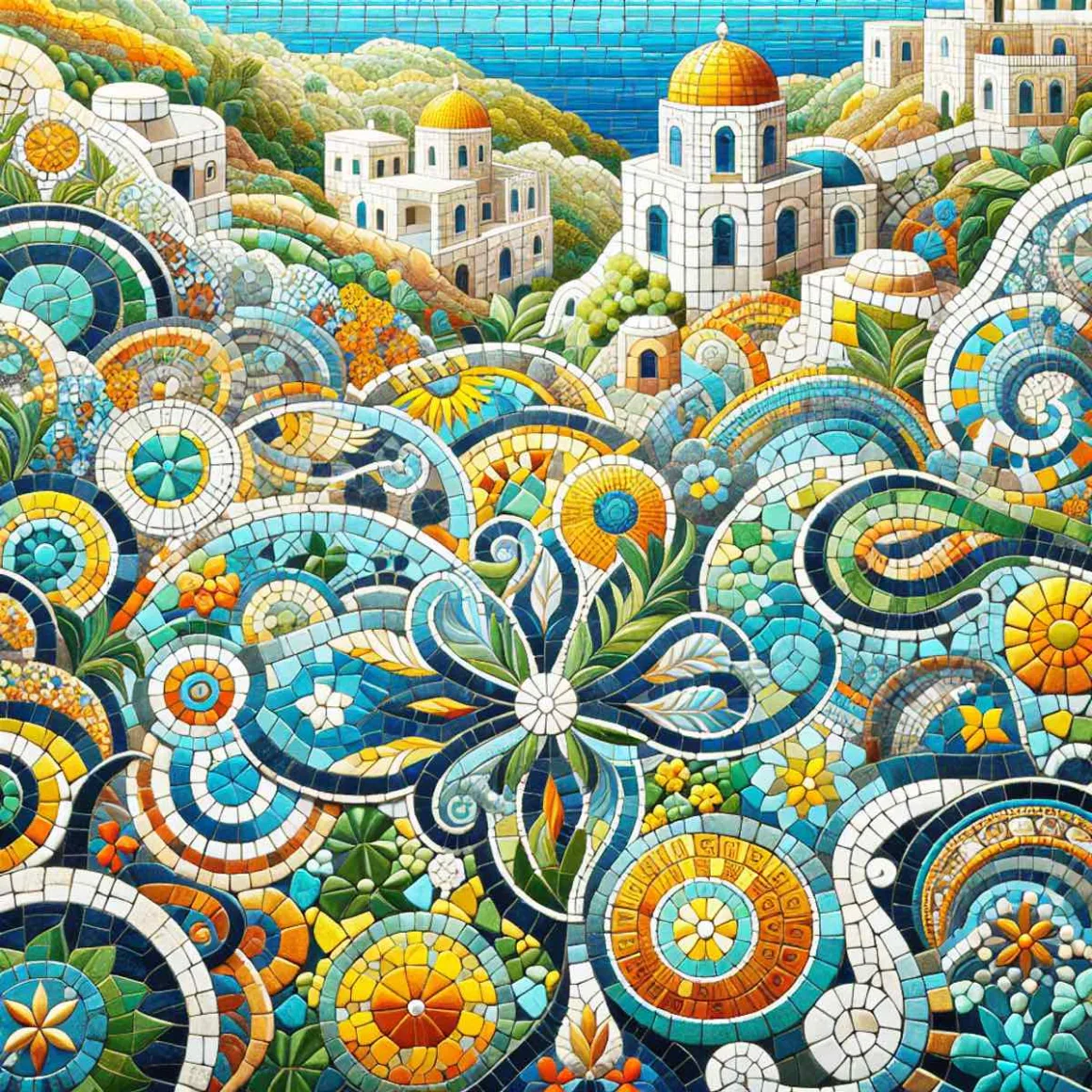
Once you’ve decided on your wall colors, it’s time to think about the floor accents. One popular way of decorating outdoor floors in true Mediterranean style is by using intricate tile patterns.
Choosing the Right Pattern
There are endless options when it comes to tile designs, from geometric patterns to floral motifs. Patterns inspired by traditional Spanish or Moroccan tiles can add a touch of elegance and visual appeal to your space.
How to Implement: You can choose to cover an entire patio with patterned tiles or create a focal point with a patterned walkway. If you find it overwhelming to redo the entire floor, consider using tiles as accents around your outdoor space – for example, as stepping stones in between gravel or grass.
Selecting the Perfect Color
When selecting tile colors, go for shades that go well with your chosen wall color. Bright blues, yellows, and greens work nicely with both terracotta and white walls. The key is to find a balance between bold patterns and the rest of your outdoor decor.
Conclusion
Designing a Mediterranean-inspired outdoor space requires careful consideration of colors and accents. Whether it’s painting your walls in earthy tones or adding intricate tile patterns to your floors, each element contributes to creating a unique Mediterranean vibe in your backyard.
Remember that home improvement is a journey that requires patience and creativity. But once done, you’ll have transformed your every day outdoors into an inviting Mediterranean oasis right at home!
Citation
- ELLE Decor. (2019, June 21). What is the Mediterranean House Style? – Characteristics of Mediterranean Houses. ELLE Decor. Retrieved March 26, 2024, from https://www.elledecor.com/design-decorate/interior-designers/a28109399/mediterranean-style-house-architecture/
- Houzz. (2024, March). 75 Mediterranean Exterior Home Ideas You’ll Love – March, 2024. Retrieved March 26, 2024, from https://www.houzz.com/photos/mediterranean-exterior-home-ideas-phbr1-bp~t_736~s_2109
- Mackenzie. (2023, October 20). 10 Mediterranean Style Homes with Exterior Updates. brick&batten. Retrieved March 26, 2024, from https://www.brickandbatten.com/mediterranean-style-homes/
- Doherty, R. (2020, July 5). Millie Mackintosh patio makeover: See her Mediterranean-inspired terrace. Ideal Home. Retrieved March 27, 2024, from https://www.idealhome.co.uk/news/millie-mackintosh-patio-makeover-251626
- Elizabeth. (2020, August 23). Garden Makeover: From Lawn To Mediterranean Courtyard Garden – What Lizzy Loves. What Lizzy Loves. https://www.whatlizzyloves.com/2020/08/mediterranean-courtyard-garden.html
FAQs (Frequently Asked Questions)
Mediterranean outdoor spaces are known for their vibrant and relaxing atmosphere, often featuring elements such as terracotta pots, porcelain paving, raised beds, pergolas, festoon lights, and Mediterranean-inspired plants and water features. The appeal lies in the ability to create a tranquil oasis that reflects the charm and warmth of the Mediterranean region.
To transform your outdoor area with a Mediterranean vibe, consider incorporating design elements such as terracotta pots, porcelain paving, raised beds, pergolas, festoon lights, outdoor furniture with a Mediterranean flair, drought-tolerant plants, water features, fire pits, cozy accessories for cool evenings, and Mediterranean-inspired colors and accents for outdoor walls and floors. These elements can help create a serene and inviting outdoor space reminiscent of the Mediterranean style.
When choosing and arranging terracotta pots to enhance the Mediterranean vibe in your outdoor space, consider using varying sizes and shapes of pots to create visual interest. Additionally, you can mix different types of Mediterranean plants within the pots to add color and texture. Placing the pots strategically around your outdoor area can also contribute to the overall Mediterranean ambiance.
Festoon lights play a crucial role in creating an enchanting evening atmosphere in Mediterranean outdoor settings. Drawing inspiration from Spanish and Italian influences, these lights add a warm and inviting glow to the space. By strategically installing festoon lights in key areas of your outdoor haven, you can achieve a captivating nightscape that embodies the essence of Mediterranean living.
Drought-tolerant plants are essential in achieving an authentic Mediterranean garden look due to their ability to thrive in dry and sunny conditions similar to those found in the Mediterranean region. These plants not only contribute to the aesthetic appeal of the garden but also require minimal water maintenance, making them practical choices for creating a sustainable and serene outdoor space.
In true Mediterranean style, it’s important to choose colors that evoke the earthy and vibrant tones commonly associated with this aesthetic. Consider options like terracotta or crisp white reminiscent of Cycladic architecture for your outdoor walls. These colors can help create a warm and inviting atmosphere while staying true to the timeless beauty of Mediterranean design.







